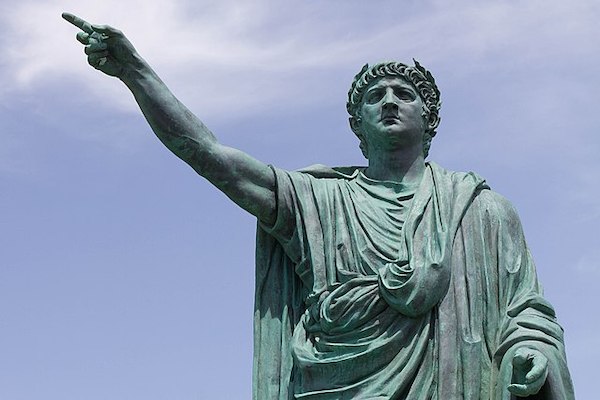
La Biografia
Nerone, nato come Lucio Domizio Enobarbo il 15 dicembre 37 d.C. ad Antium, vicino a Roma, era figlio di Gneo Domizio Enobarbo e Agrippina la Giovane, sorella dell’Imperatore Caligola. Come era consuetudine per l’aristocrazia romana, fu istruito a casa, ricevendo un’instruzione dal filosofo Seneca.
Il regno di Nerone fu contrassegnato da eccessi, omicidi politici e un’attenzione senza precedenti alla diplomazia pubblica. Dopo aver succeduto a Claudio – suo padre adottivo, Nerone eliminò gradualmente i potenziali rivali al trono, incluso sua madre Agrippina, che ordinò di uccidere.
Nerone è forse meglio ricordato per il Grande Incendio di Roma. Circolavano voci che lo stesso Nerone avesse ordinato l’incendio per poter ricostruire Roma secondo i suoi gusti. Incolpò poi i cristiani per il disastro, portando alla loro persecuzione. La sua costruzione della Domus Aurea (“Casa Dorata”), un palazzo di grande magnificenza con giardini, un lago artificiale e una statua colossale di sé stesso, mostrava il suo amore per l’opulenza.
Nonostante le brutalità e le controversie, Nerone era popolare tra il popolo comune di Roma, principalmente grazie ai suoi sfarzosi giochi pubblici e alla riduzione delle tasse.
Appassionato patrono delle arti, Nerone si considerava un artista e un interprete. Il suo amore per la cultura ellenistica portò alla Neronia, un festival pubblico che includeva musica, poesia e atletica, basato sulle tradizioni greche.
Nerone morì suicida a Roma il 9 giugno 68 d.C., pronunciando le famose ultime parole: “Che artista muore in me!”
Non esistono statue contemporanee di Nerone, sebbene le sue rappresentazioni possano essere trovate su monete e in bassorilievi. La sua morte segnò un significativo periodo di disordini civili noto come “l’Anno dei Quattro Imperatori”.
La vita di Nerone continua a affascinare storici e studiosi, con il suo regno che serve come lezione sui pericoli del potere assoluto. Nonostante il suo regno tirannico, l’influenza di Nerone su arte e architettura rimane notevole.
(Testo generato da ChatGPT4, giugno 2023. Revisione contenuti e formattazione a cura di Manuela Filomena)
Biography
Nero, born as Lucius Domitius Ahenobarbus on December 15, AD 37, in Antium, near Rome, was the son of Gnaeus Domitius Ahenobarbus and Agrippina the Younger, sister of Emperor Caligula. As was customary for Roman aristocracy, he was tutored at home, receiving education from the philosopher Seneca.
Nero’s reign was marked by extravagance, political murders, and an unprecedented focus on public diplomacy. After succeeding Claudius – his adoptive father, Nero gradually eliminated potential rivals to the throne, including his own mother Agrippina, whom he ordered to be killed.
Nero is perhaps best remembered for the Great Fire of Rome. Rumors circulated that Nero himself had ordered the fire so that he could rebuild Rome according to his tastes. He then blamed the Christians for the disaster, leading to their persecution. His construction of the Domus Aurea (“Golden House”), a palace of grandeur with gardens, an artificial lake, and a colossal statue of himself, showcased his love for lavishness.
Despite the brutalities and controversies, Nero was popular with the common people of Rome, mainly due to his lavish public games and reduction of taxes.
An avid patron of the arts, Nero fancied himself an artist and performer. His fondness for Hellenistic culture led to the Neronia, a public festival encompassing music, poetry, and athletics, based on Greek traditions.
Nero died by suicide in Rome on June 9, AD 68, uttering the famous last words, “What an artist dies in me!”
There are no surviving contemporary statues of Nero, although his representations can be found on coins and in relief sculptures. His death marked a significant period of civil unrest known as the “Year of the Four Emperors.”
Nero’s life continues to fascinate historians and scholars, with his rule serving as a lesson in the dangers of absolute power. Despite his tyrannical reign, Nero’s influence on arts and architecture remains noteworthy.
(Text generated by ChatGPT4, June 2023. Edited for style and content by R.H. Ruggles)
Risorse Internet

